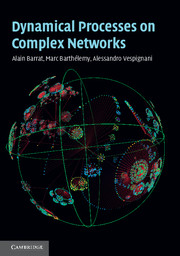Book contents
- Frontmatter
- Contents
- Preface
- Acknowledgements
- List of abbreviations
- 1 Preliminaries: networks and graphs
- 2 Networks and complexity
- 3 Network models
- 4 Introduction to dynamical processes: theory and simulation
- 5 Phase transitions on complex networks
- 6 Resilience and robustness of networks
- 7 Synchronization phenomena in networks
- 8 Walking and searching on networks
- 9 Epidemic spreading in population networks
- 10 Social networks and collective behavior
- 11 Traffic on complex networks
- 12 Networks in biology: from the cell to ecosystems
- 13 Postface: critically examining complex networks science
- Appendix 1 Random graphs
- Appendix 2 Generating functions formalism
- Appendix 3 Percolation in directed networks
- Appendix 4 Laplacian matrix of a graph
- Appendix 5 Return probability and spectral density
- References
- Index
6 - Resilience and robustness of networks
Published online by Cambridge University Press: 05 September 2012
- Frontmatter
- Contents
- Preface
- Acknowledgements
- List of abbreviations
- 1 Preliminaries: networks and graphs
- 2 Networks and complexity
- 3 Network models
- 4 Introduction to dynamical processes: theory and simulation
- 5 Phase transitions on complex networks
- 6 Resilience and robustness of networks
- 7 Synchronization phenomena in networks
- 8 Walking and searching on networks
- 9 Epidemic spreading in population networks
- 10 Social networks and collective behavior
- 11 Traffic on complex networks
- 12 Networks in biology: from the cell to ecosystems
- 13 Postface: critically examining complex networks science
- Appendix 1 Random graphs
- Appendix 2 Generating functions formalism
- Appendix 3 Percolation in directed networks
- Appendix 4 Laplacian matrix of a graph
- Appendix 5 Return probability and spectral density
- References
- Index
Summary
The large-scale collapses of the electric distribution grid or internet outages have shown that the stability of complex networks is a problem of crucial importance. The protection of critical infrastructures or the elaboration of efficient reaction strategies all rely on the identification of crucial (or weak) elements of the network and on the understanding of the progressive damage caused by successive removals or failures of nodes. In this context, it has been observed that complex network models usually display great stability even if they are confronted by a large number of repeated small failures, while at the same time major damage can be triggered, unpredictably, by apparently small shocks. This is also consistent with empirical experience in which unexpected, small perturbations may sometimes trigger large systemic failures.
In this chapter, we deal with the impact of the removal or failure of nodes in complex networks by studying their percolation behavior. Percolation models and the associated critical phenomena have been extensively studied in statistical physics and, even though they are not endowed with a high level of realism, they can be thought of as the zeroth order approximation to a wide range of damaging processes. In particular we focus on heterogeneous networks that typically display both a large robustness to random failures and a high vulnerability to targeted attacks on the most crucial nodes.
- Type
- Chapter
- Information
- Dynamical Processes on Complex Networks , pp. 116 - 135Publisher: Cambridge University PressPrint publication year: 2008
- 1
- Cited by



